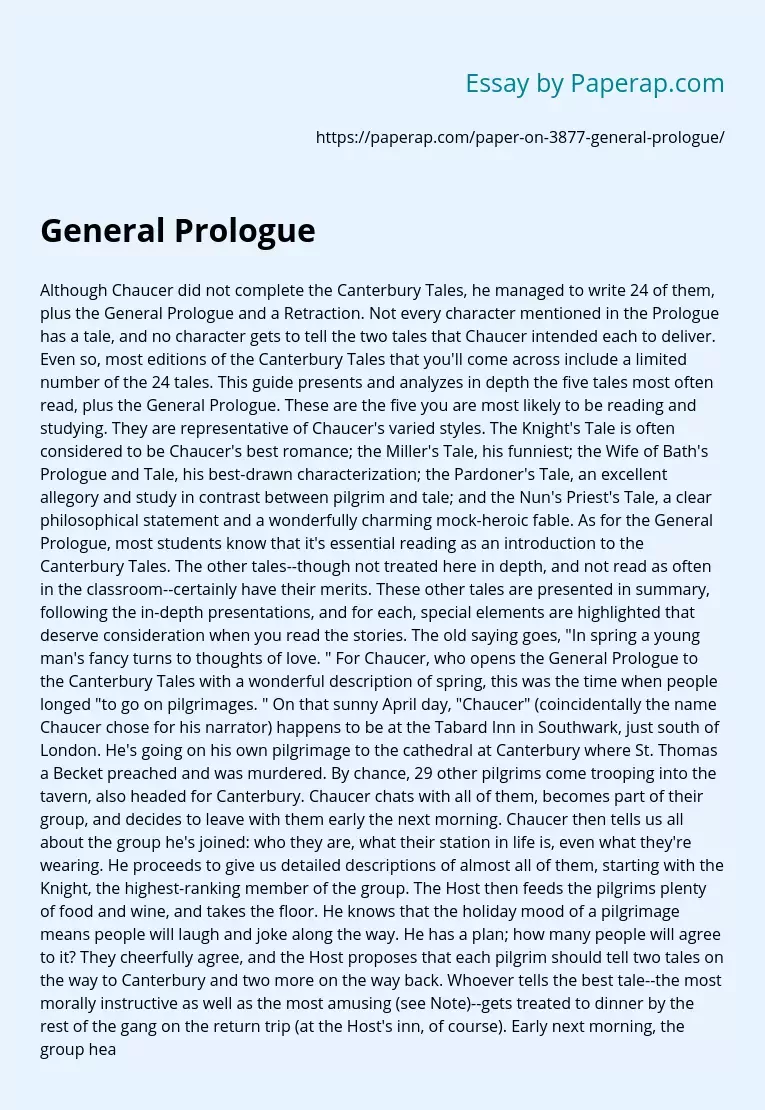Chaucer’s Five Most Read Tales
Although Chaucer did not complete the Canterbury Tales, he managed to write 24 of them, plus the General Prologue and a Retraction. Not every character mentioned in the Prologue has a tale, and no character gets to tell the two tales that Chaucer intended each to deliver. Even so, most editions of the Canterbury Tales that you’ll come across include a limited number of the 24 tales. This guide presents and analyzes in depth the five tales most often read, plus the General Prologue.
These are the five you are most likely to be reading and studying.
They are representative of Chaucer’s varied styles. The Knight’s Tale is often considered to be Chaucer’s best romance; the Miller’s Tale, his funniest; the Wife of Bath’s Prologue and Tale, his best-drawn characterization; the Pardoner’s Tale, an excellent allegory and study in contrast between pilgrim and tale; and the Nun’s Priest’s Tale, a clear philosophical statement and a wonderfully charming mock-heroic fable.
As for the General Prologue, most students know that it’s essential reading as an introduction to the Canterbury Tales.
The other tales–though not treated here in depth, and not read as often in the classroom–certainly have their merits. These other tales are presented in summary, following the in-depth presentations, and for each, special elements are highlighted that deserve consideration when you read the stories. The old saying goes, “In spring a young man’s fancy turns to thoughts of love. ” For Chaucer, who opens the General Prologue to the Canterbury Tales with a wonderful description of spring, this was the time when people longed “to go on pilgrimages.
” On that sunny April day, “Chaucer” (coincidentally the name Chaucer chose for his narrator) happens to be at the Tabard Inn in Southwark, just south of London. He’s going on his own pilgrimage to the cathedral at Canterbury where St. Thomas a Becket preached and was murdered. By chance, 29 other pilgrims come trooping into the tavern, also headed for Canterbury. Chaucer chats with all of them, becomes part of their group, and decides to leave with them early the next morning.
Chaucer then tells us all about the group he’s joined: who they are, what their station in life is, even what they’re wearing. He proceeds to give us detailed descriptions of almost all of them, starting with the Knight, the highest-ranking member of the group. The Host then feeds the pilgrims plenty of food and wine, and takes the floor. He knows that the holiday mood of a pilgrimage means people will laugh and joke along the way. He has a plan; how many people will agree to it?
They cheerfully agree, and the Host proposes that each pilgrim should tell two tales on the way to Canterbury and two more on the way back. Whoever tells the best tale–the most morally instructive as well as the most amusing (see Note)–gets treated to dinner by the rest of the gang on the return trip (at the Host’s inn, of course). Early next morning, the group heads out and the Host has everyone draw straws to see who will tell the first tale. The Knight picks the shortest straw, and the Prologue ends as the Knight prepares to speak.
NOTE: The scheme of two stories out, two back was never completed by Chaucer. Instruction plus amusement were the criteria by which good stories were judged in Chaucer’s day. Originality was not important, but embellishment, and how well a story was adapted, were highly valued. It is fitting that the Knight, “by cas” (by chance) picks to go first, as he is the highest in the social hierarchy on the trip. Chaucer is saying the choice seems random, but is not. This idea resurfaces throughout the Tales.
Chaucer’s Five Most Read Tales. (2017, Aug 25). Retrieved from https://paperap.com/paper-on-3877-general-prologue/

